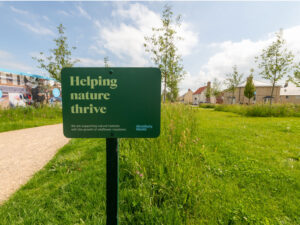How does BNG affect Landscape Contractors?
Biodiversity Net Gain (BNG) is transforming the landscape industry, placing a greater emphasis on ecological design and long-term maintenance. This presents exciting opportunities for Landscape Contractors and Landscapers alike.



Shifting Focus: Traditionally, landscapes might have prioritised aesthetics or functionality. Now, Contractors and Landscapers will need to factor in creating biodiverse environments. This might involve using native plants, safeguarding existing habitats and employing sustainable landscaping practices. Wildflower Turf Ltd are here to help you adapt.
Collaboration: BNG requires more collaboration between Landscape Contractors, Landscape Architects and Ecologists from project inception. Ecologists will assess the site’s existing biodiversity and develop plans with Landscape Architects to achieve a 10% net gain, and the Landscape Contractors will be responsible for implementing those plans.
Following Specified Designs: The Landscape Architect’s plan, informed by ecological expertise, will dictate the plant species, materials, and features needed to achieve BNG targets. While there might be some flexibility for minor adjustments, the core elements are pre-determined and won’t be able to be value-engineered. This ensures the project aligns with BNG’s goals.
Long-term management plans: BNG sites require a 30-year commitment. This means Landscape Contractors may be tasked with maintaining all living aspects of the project, creating long-term opportunities. This includes replacing failed plants, repairing damaged areas, and ensuring BNG targets are met during regular audits. In some cases, collaboration with the Landscape Architect may be needed during this period to adjust designs or management plans if targets aren’t being met.
How can Wildflower Turf Ltd support you?

>> Explore our product mixes.

Effortless Quotes: Request a quote for your projects day or night here. Alternatively, our team of passionate and knowledgeable experts are ready to assist you on 01256 771222 during weekday opening hours.

>> Learn about the differences between our product ranges

>> Explore our range of training courses at Wildflower Turf Ltd.

>> Discover training opportunities related to BNG principles

>> Discover the benefits of becoming an Accredited Partner
Frequently Asked Questions about BNG
Biodiversity Net Gain (BNG) is a way of creating and improving natural habitats. BNG ensures new developments have a positive impact on biodiversity of at least a 10% increase compared to the biodiversity prior to development; it must be maintained for a minimum period of 30 years.
Classification of the type, distinctiveness, condition, connectivity and strategic significance of habitats by a professional prior to and post development.
Local authorities (excluding parish councils) and local planning authorities must publish a biodiversity report. Alongside that, development sites that are being built either on or next to an area of importance for biodiversity will require a biodiversity report and survey to publish alongside the planning application.
Biodiversity index is calculated by finding the total number of species in the designated area and dividing that by the total number of individuals in that area. The scientific equation is dividing species richness by species evenness.
BNG credits have a range of prices dependent on the habitat that is being disturbed. They are categorised into low, medium and high habitat distinctiveness (HD), as well as broad and specific habitat type and, finally, tier. Credits start at a cost of £42,000 for low HD and tier A1. In the medium HD section, prices range from £42,000 for Heathland Shrub at tier A1 to £125,000 for sparsely vegetated land and other inland rock and scree at tier A4.
At high HD, prices again begin at £42,000 for wetland and reedbeds at tier A1 and range up to £650,000 for lakes and peat lakes in tier A5. Additionally, there is also a section for various HD for hedgerows at £44,000 and all watercourses at £230,000.